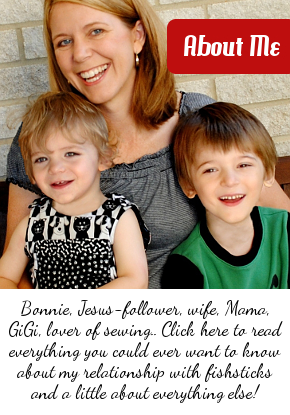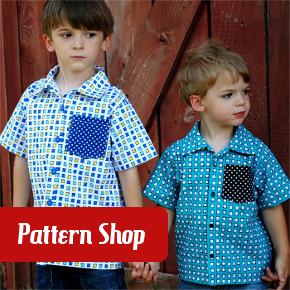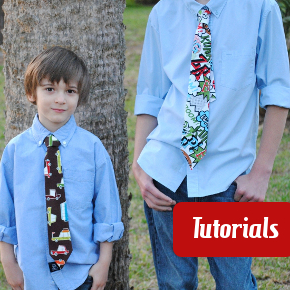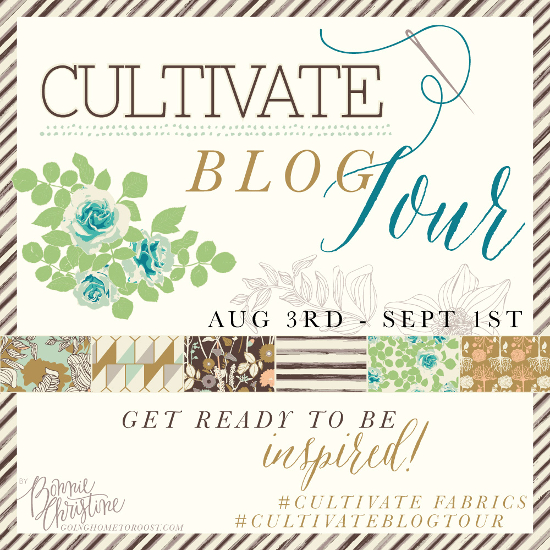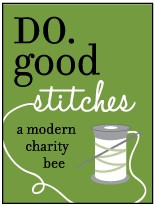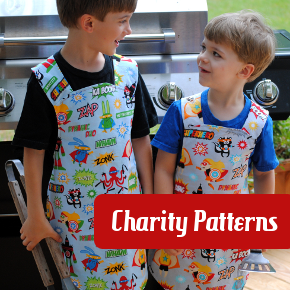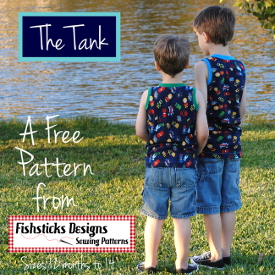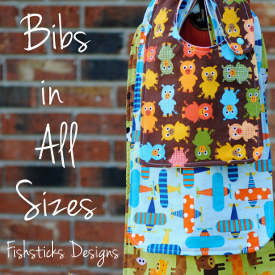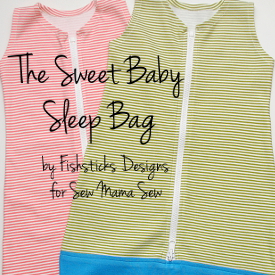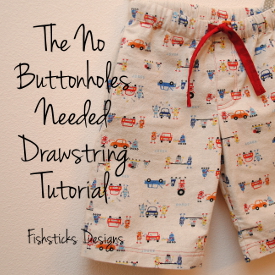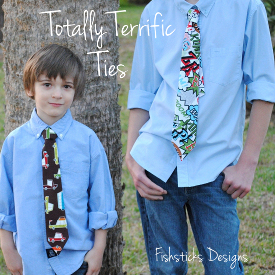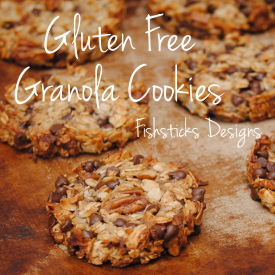Bonnie
Knit Knowledge–Simple Appliques & Hemming Tips

Now that you know all about the different types of knits. Let’s learn a little about adding the finishing details and a little extra punch to your knit sewing projects.
Because knits don’t fray like wovens, appliqueing with them is really easy! Here are the few things that you need to get started: a fabric that you’d like to applique, a fabric cut to applique on and a lightweight iron-on adhesive product like HeatnBond Lite (you want one that says it’s “sewable”).

Begin by using a washable marker to outline the sections that you’d like to cut out of your applique fabric.

Trim down your applique fabric so you have just a little extra left outside of the actual applique outlines, and cut out a piece of iron-on adhesive the same size as the applique fabric you have left.

Iron the applique fabric to the iron-on adhesive.

Cut out your appliques. (I cut just inside the washable marker.)

Peal the backing off of the iron-on adhesive.

Decide on the position of your appliques keeping the seam allowances in mind. (This is the side panel from the vertical colorblocked Charlie Tee, so it has a 1/2″ seam allowance.) You’ll see here that I decided after laying them out that I needed an additional smaller applique at the top to balance things out.

Iron the applique on to the main fabric. (If you’ll be overlapping them a bit like mine, start with the one on the bottom of the overlapping.)

Now just stitch around the applique. I generally keep my stitching about 1/8″ to 1/4″ from the edge. I intentionally did these a little messy, and I love the look!

Add a few more, if you’d like. Now wasn’t that easy?

I’m covering hemming last, but when I sew knits, I always hem first. I’ve found that hemming when you have a flat piece of fabric cuts down tremendously on the amount of puckering that you’ll have in your finished project. I covered hemming on my blog a while back. You’ll find my original post here: Hemming Knits Part 1. All of those tips are still great and work really well. I have, however, personally changed my hemming method a little. The way I was hemming then worked great for my guys until they got a bit bigger and started stretching and pulling on their clothes. Then, even with the stretchy nylon thread in the bobbin, our hems were breaking.
I was sharing my frustration over this with my friend, Michelle, one day, and she asked me if I used the triple-stretch stitch on my machine. Hmmmm. . . I’d never even heard of that! See–I told you I’m still learning new things along the way. Now, though, thanks to Michelle, I have a method of hemming that never fails! It takes a few extra minutes, but I think it’s worth the extra effort to have a finished product that not only will last for one season, but that I can pass down from child to child.
Here’s what that triple stretch stitch looks like on my machine. It’s stitch #5. (Am I the only one who didn’t know about it before?)

I start out my hemming by either folding up part way and folding up again or by serging off the edge and then folding up the hem allowance. (If you’re just starting with knits, use the first method because stitching through that extra layer will help cut down on the stretching while you’re sewing.) 
If your knit fabric is really stretchy or if it’s rolling on you, use a little spray starch before you press.

Now, when I sew with knits, I always (ALWAYS!) have a stretchy nylon serger thread in my bobbin. (I’ve used Wooly Nylon in the past. Now I’m using Maxilock Stretch.) When I start my hem, I like to sew on the inside. If you only have white stretchy nylon serger thread, then you’ll have to sew on the right side if your fabric isn’t white, though. In this case, I’m sewing on the inside for the first step: straight across the top of the hem using a regular straight stitch.

I left the orange thread from the applique above as the top thread so you could see that I sewed this step on the inside.

Then I flip my fabric piece over and switch to the triple stretch stitch, and sew again on the front side of the fabric right on top of the original stitching.

(Now you’re wondering why I don’t just use the triple stretch stitch and skip the first step. I tried that, but the triple stitch pulls the fabric back and forth under the presser foot to make three stitches side by side, and I found that if I didn’t sew down the whole length first, I always ended up with wonkiness. I’m assuming that’s because of the back and forth motion of the triple stretch stitch.)

All done! A hem that won’t disappoint you!

HEMMING UPDATE:
When I wrote the above information about hemming knits, I was looking for a great way to hem that wouldn’t come undone. The preferred way to hem knits is with a twin needle. It gives a nice side-by-side double stitch on the front with a zig-zag on the back which allows the fabric to stretch without the stitches popping. At the time, I’d been unable to master using a twin needle which, frankly, given that I have a business built on sewing with knits, was a bit embarrassing.
Not too long after this Knit Knowledge Series wrapped up, I got determined to figure out this twin needle thing once and for all. I sat down at the machine, pulled out my twin needle and grabbed the manual for my machine. I skimmed over the instructions as I’ve done in the past, but something new caught my eye.
Do I admit that it was there all along, or do I try and convince you that someone must have added this little detail to my owner’s manual secretly at some point? What is this little bit of important information? Well, the instructions for twin needle sewing begin, “Press the twin needle key to enter the twin needle sewing mode.” Wait! What?! There’s a twin needle key? Oh, look, there it is. (In fact, if you scroll up to where I posted the picture of the touch pad on my sewing machine, you can see it on the bottom center of the screen.)
And guess what happened? I pressed that little key, installed the twin needle, threaded everything up, and I’ve stitched all my hems beautifully with a twin needle since. I suppose that’s a good lesson in reading the instructions . . . and if it still doesn’t work after you’ve read the instructions, maybe you should read them again.

Easy Applique with Knits
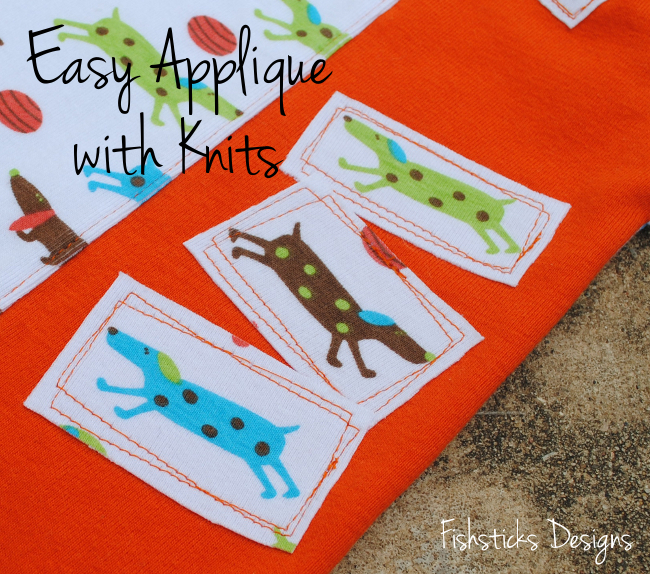
Because knits don’t fray like wovens, appliqueing with them is really easy! Here are the few things that you need to get started: a fabric that you’d like to applique, a fabric cut to applique on and a lightweight iron-on adhesive product like HeatnBond Lite (you want one that says it’s “sewable”).
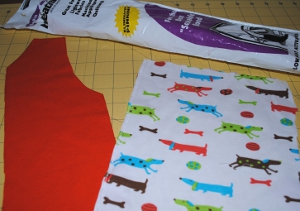
Begin by using a washable marker to outline the sections that you’d like to cut out of your applique fabric.
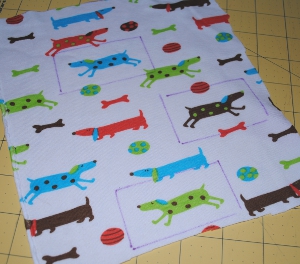
Trim down your applique fabric so you have just a little extra left outside of the actual applique outlines, and cut out a piece of iron-on adhesive the same size as the applique fabric you have left.
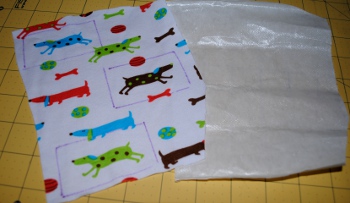
Iron the applique fabric to the iron-on adhesive.
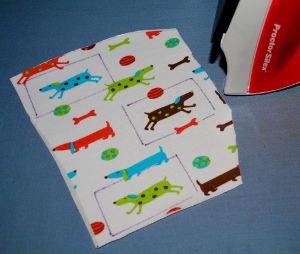
Cut out your appliques. (I cut just inside the washable marker.)
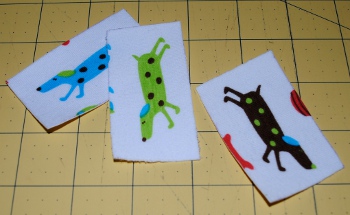
Peal the backing off of the iron-on adhesive.
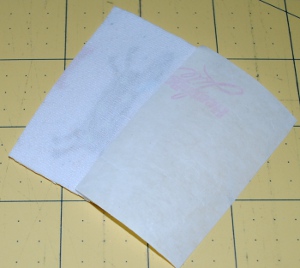
Decide on the position of your appliques keeping the seam allowances in mind. (This is the side panel from the vertical colorblocked Charlie Tee, so it has a 1/2″ seam allowance.) You’ll see here that I decided after laying them out that I needed an additional smaller applique at the top to balance things out.
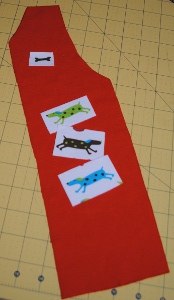
Iron the applique on to the main fabric. (If you’ll be overlapping them a bit like mine, start with the one on the bottom of the overlapping.)
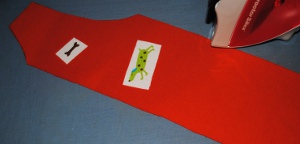
Now just stitch around the applique. I generally keep my stitching about 1/8″ to 1/4″ from the edge. I intentionally did these a little messy, and I love the look!
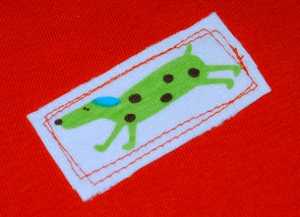
Add a few more, if you’d like.
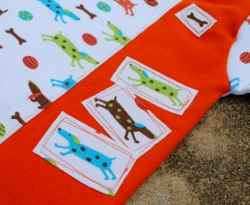
Finish sewing your item and admire your work!
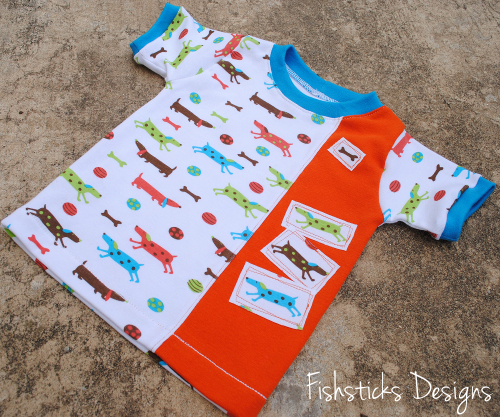
Knit Knowledge–Ribbed Knits, Ribbing & Pile Knits

Ribbed knits are the stretchiest of the three main types of knits. Ribbed knits are characterized by the vertical ribs that you’ll see when you give the fabric a little stretch.

100% cotton ribbed knits tend to be very soft and are great for the bodies of tees, pajamas, baby clothing and lots more. They aren’t great for necklines or trim that needs good recovery, though, because they tend to stretch out and not bounce back.



I find cotton ribbed knits the most difficult to work with because they stretch so much. You have to take the greatest amount of care with them to not stretch while you’re sewing. With ribbed knits, a walking foot is really a must! It’ll help prevent seams that look like this (more about hemming tomorrow):


Ribbing is actually a type of ribbed knit. It sometimes comes in a tube rather than flat on a bolt. Ribbing usually has a small amount (3%-5%) of lycra or spandex mixed with the cotton fibers. Because of the lycra or spandex, ribbing is perfect for neckbands, trim and waistbands. (The Comfy Sleep Set in Stitch magazine uses cotton/spandex ribbing for the waistband.)


In addition to the three main types of flat knits that we’ve already discussed, there are knits that have a pile or texture to them. French terry is smooth on the front side and has loops on the back. French terry works well for lightweight loungepants and sweatshirts. Sweatshirt fleece is similar to french terry only the loops on the back side are cut and brushed for a softer feel. Sweatshirt fleece is usually a bit heavier than french terry as well. Both french terry and sweatshirt fleece have very little stretch. Sewing either of them is similar to sewing woven fabrics.



Stretch terry is the fabric that you’ll most often find in hooded baby towels. It’s the opposite of french terry with the loops on the front and a smooth back. Stretch terry is usually cotton on the front with a backing of polyester and has a good amount of stretch. Velour is basically stretch terry with the loops sheared off and brushed smooth. Cotton velour is luxuriously soft and squishy. It, too, usually has polyester in the backing and stretches well. It’s a perfect choice for baby clothing and loungewear, and our favorite use for it this time of the year is in cloth tissues. They are so, so soft on sore runny noses.



Oh, the questions! They are awesome. Many of them I can answer. Some of them, though, have sent me off researching. I love it! Keep ’em coming! For an entry into this week’s drawing, add a comment to this post with either a question that you’d like me to answer on Friday–I won’t get to answer them all, but I will answer as many as I can–or comment with an answer to this question from me: Today’s question is, “What is your favorite knit print that is available to purchase today?” If you don’t yet have a favorite, go do a little window shopping and see what you can find. You can start at The Fabric Fairy and dream a little about what you’d spend the $20 gift certificate that Caroline has donated if you win!
Knit Knowledge–Interlock Knits and Jerseys
INTERLOCKS

I’m starting out with interlocks, specifically cotton or cotton/polyester blend interlocks, because I always recommend that beginners start with interlock. Honestly, given a choice, I will almost always choose cotton interlock when sewing knit clothing for my family. It has such great qualities. Interlock has a nice weight to it–not too heavy, not too light–which makes it easy to sew and comfortable to wear. It has a good amount of stretch and good recovery. (Recovery is a knit fabric’s ability to bounce back to the size it started. Some knits stretch out and stay stretched until they’re washed and dried.)
Interlocks have the traditional “v” knit shape in the weave on both the front and the back of the fabric. In solid colors, it’s really impossible to tell a difference between the sides of the fabric.



I use cotton and cotton/polyester interlock for the main body sections of tops and pants and for neckbands, armbands and legbands. If you use it for a waistband, though, you will need to hide elastic inside. (Cotton/lycra or cotton/spandex blends are better for elastic-free waistbands. We’ll get to those later.)
JERSEYS

Jerseys are lighterweight than interlocks. If you grab a t-shirt from your closet, you’ll most likely find that it was sewn with cotton jersey. Jerseys are easy to recognize. They have that “v” knit pattern in the weave on the front and the “-” purl pattern in the weave on the wrong side of the fabric. Jerseys also roll on the cut edges.

It’s the rolling that often makes jerseys difficult to work with. I have a couple of suggestions for dealing with the rolling. Experience has shown me that the best way to deal with it is to cut and sew right away. The longer you leave a jersey to sit after you’ve cut out your pattern, the more rolling you’re going to have to deal with. When you first cut, the fabric will lie fairly flat. Another thing you might try is spraying the edges with a little spray starch, then ironing to help them hold their shape while you sew.


100% cotton jerseys have a minimal amount of stretch and are great for the bodies of tees. They work well in pajama pants and baby clothing, too. You’ll also find jerseys made from a list of other natural and synthetic fabrics along with blends of natural and synthetic fibers. I prefer cotton/lycra and cotton/spandex jerseys in the tops that I sew for myself because of the nice drape and the extra stretch that the spandex or lycra adds. Those same cotton/lycra and cotton/spandex jerseys also work well in yoga-style waistbands on skirts or loungepants because of their superb recovery.

Keep the questions coming! Remember that you’ll get an entry into Friday’s drawing for a $20 gift certificate from The Fabric Fairy for every question or comment you post this week (one comment or question per person per blog post, please). Today’s question for you, in case you don’t have a question for me, is “If you’re already comfortable with sewing knits, what type of clothing do you sew most often? If you’re not, what items of clothing do you think you’d choose to sew if you were?”
Knit Knowledge – Introduction & Overview

Welcome to Knit Knowledge Week! I’m asked questions about working with knit fabrics really often, so I thought I’d spend a week sharing some of my knowledge with you. I’m quite certain that I don’t know everything there is to know about working with knits, and I still occasionally discover a new technique that works better than what I was doing before. Everything I’ll share is what I’ve learned through my own hands-on experience.
My plan is to spend the week sharing a bit each day. Here’s the lineup that I have planned: Monday: Knit Overview, Tuesday: Interlock Knits & Jerseys, Wednesday: Ribbed Knits & Ribbing, Thursday: Hemming & Simple Applique, Friday: Questions & Answers and the Giveaway.
This week will require some participation from you, too. In order for me to have a Q&A on Friday, I need you to post any questions that you have in the comments section Monday through Thursday. Then, I’ll choose as many questions as I can and answer them on Friday (if I haven’t already answered them during the week).
Friday’s post will also include an exciting giveaway! Caroline at The Fabric Fairy has generously donated a $20 gift certificate that you can use in her store to purchase some knit fabrics from her incredible selection to try out for yourself. Just comment on my posts Monday through Thursday (one comment per post, please), and I’ll hold a random drawing on Friday morning.
Alrighty, let’s get started with a quick overview.
OVERVIEW
First off, don’t be afraid of knits! Knit fabrics, primarily cotton and cotton-blend knit fabrics, are what most of us live in! Once you become comfortable sewing them, you’ll be ready to sew up whole wardrobes of comfortable clothing that you and your loved ones will love to wear.
THE BASICS
ThinkQuest explains, “Knitted fabrics are made from a single yarn or a set of yarns. In making cloth, a knitting machine forms loops in the yarn and links them to one another by means of needles. The finished fabric consists of crosswise rows of loops, called courses, and lengthwise rows of loops, called wales. This looped structure makes knitted fabrics more elastic than woven cloth. Garment manufacturers use knitted fabrics in producing comfortable, lightweight clothing that resists wrinkling.”
Simply put, knit fabrics have stretch. Some, like sweatshirt fleece, have only a little stretch. Others, like cotton ribbed knits, have a whole lot of stretch.
The stretch in most knit fabrics runs across from selvage to selvage. When you place your pattern pieces on knit fabrics that show grainlines rather than direction of stretch, you generally want the grainline to run perpendicular to the stretch.
The right tools:

Before working with knit fabrics, you’ll want to switch out the regular foot on your machine for the walking foot. Your sewing machine has “teeth” that guide the bottom of the fabric under the foot while the needle sews. A walking foot has similar teeth that grip the top of fabric so top and bottom pass through under the needle evenly. This feature helps a great deal in cutting down on the amount of puckering that you’ll see in your knit fabric seams.

It’s also a good idea to switch out your sharp sewing machine needle for a ballpoint needle. Sharp needles cut through the knit loops on your fabrics and leave the fabric with small holes which tend to grow larger as the garment is pulled on and off. Ballpoint needles are designed to glide through the loops instead without causing harm to the fibers. Knit garments sewn with ballpoint needles will hold up much better over time.

The third tool that I think is worth mentioning is a serger. It’s a bit of an investment, and you definitely don’t needone to sew knit garments. (All of my patterns include instructions for sewing with a regular sewing machine, as well as a serger.) However, if you’re planning to sew a lot of knit garments, a serger will give you a nice finish to the inside, as well as a sturdier finished item. Once you get the hang of using a serger, you’ll also find that serging together a piece of clothing is much faster than sewing!
So those are few basics to get you started. To get your giveaway entry today, you’ll need to leave a comment. You can either leave a comment with a question that you’d like me to answer about sewing with knit fabrics, or you can answer my question for today, “What’s your favorite thing about wearing clothing made with knit fabrics?”
Oh, one more thing! As a thank-you for joining me this week, I’ve added a 20% discount code that you can use on any of my patterns through Friday: KnowKnits.
Happy 1st Birthday, Charlie!

Our little guy, Charlie is one year old! We affectionately refer to him as “Charlie Brown” all the time, so I was beside myself with excitement a few months ago to run across this Peanuts cotton knit fabric. I combined my Patrick Curved Raglan and my new Austin Lee Coverall to make his 1st birthday outfit.
I knew that I wanted a quilted bib to go with it, and I found the perfect cotton woven coordinate at Joanns last week. I used Busy Quilt Mom’s Perfect Fit Bib pattern for the bib. (We have a collection of these that I really need to show off to you. It’s a lovely pattern!)
Here’s the birthday boy in his Patrick Curved Austin Lee Coverall:

Charlie loves cuddling with stuffies, so I used the Bit of Whimsy Nutmeg Gnome pattern to sew up this sweet lovey for him as a first birthday gift.

Yay! I think this lovey is going to get lots of love!

Charlie had a wonderful birthday celebration, and he thoroughly enjoyed his birthday cake!





Happy Birthday, my Charlie Brown! You bring such great joy to our whole family. What an incredible blessing you are!
The Austin Lee Coverall & Romper is Ready!

The Austin Lee Coverall & Romper Pattern goes on sale at noon today!
I’ll be back tonight with pictures from Charlie’s first birthday party this afternoon, and tomorrow I start my series on sewing with knit fabrics. I’m really excited about sharing my knowledge, and they’ll be a fun prize at the end of the week . . . and a discount coupon code that will be good on any of my patterns all week.

The Winner of Stitch Giveaway #2

All the entries–printed, cut apart and folded–ready to be chosen.

And, the winner is . . .

. . . Laura B of Lil Bean Baby! Congratulations, Laura! Laura is an amazing seamstress and her knitting is just incredible. You have to take a minute to go check out her blog. And, I happen to know that Laura is expecting a new little bean that the Comfy Sleep Set will be perfect for! Hmmm . . . I wonder if she’ll pick the Dino Dudes or the Mod Blooms interlock.
Oh, and you might have noticed that my helper for the drawing is wearing a Comfy Sleep Set in a bigger size. I have had quite a few moms ask if I could draft up sizes 18 months to 4T so that big brothers and sisters can have Comfy Sleep Sets, too. I checked in with Stitch, and they said they’d be happy for me to add the bigger sizes! I’m sure it’ll take me several weeks to get it done, but they’re coming. (This draft actually needs a little work–the neckline is bigger than I’d like it, and there are a few other little adjustments to be made. Jamie’s totally happy with it, though. He loves having Dino Dude pjs to match little brother, Charlie!)

Snow Day!

It’s coooooold outside, and six inches or so of snow fell overnight here in Dallas. We’re feeling a little cooped up inside since sleet and ice-covered roads from earlier in the week have kept us from being out and about. We’re doing our best to make the best of it, though.

Since schools and businesses are closed, Ray gets to spend his birthday home with the family. Jamie and I made chocolate chip banana muffins this morning while everyone else slept in a little.
I do have a few projects on my cutting table, though. Celebrate the Boy starts at Made-by-Rae on February 15th, and I’m so excited that Rae has invited me to share a free pattern/tutorial on March 11 to go with my recently release Undercover Bottoms Boxer Briefs pattern. It’ll be something that I think you’ll love. It’s a perfect clothing item for layering in the winter and keeping cool and comfy during the summer.

I also have plans for an All-About-Knits Week starting on February 14th. Be sure to drop in and read while I share some of my knowledge of knit fabrics and tips for working with them.
My testers are just about finished with the coverall and romper pattern. I just have to do a few final tweaks, and I have to decide on a name. It should be ready to sale by the end of next week.
Lastly, in case you missed it, my New Year’s resolutions were published on the last page of the Spring Stitch magazine:

I’m really excited about sewing a whole season’s wardrobe for Charlie and Jamie. I’m thinking of shooting for a summer wardrobe. (Planning now while there’s six inches of snow on the ground seems a little odd, but summer will be here in no time!) I was also thinking that it might be fun to have you join me. Maybe a One Wardrobe for One Season Challenge? Anyone interested?
Oh, and before I forget to remind you, Stitch Giveaway #2 ends on Tuesday night, so there’s still time to enter!
My Baby Girl is a Teenager!

Do you ever wish you could slow down time? Samantha, child number three in our family and our youngest girl, turned 13 yesterday! It’s so hard to believe that this young lady was once such a teeny baby, arriving five weeks before her due date. Today she’s a beautiful girl with a smile to share with everyone.
We celebrated her birthday with dinner out on Monday night since we’d heard that bad weather was coming in. We spent her actual birthday huddled up in our house enjoying a “snow/ice day”. Even Dad and big brother, Sean, got the day off to spend with us. Plenty of chocolate cake and mint chocolate chip ice cream was enjoyed by all.

Quite some time ago, Samantha asked me to make her some pajamas from some Little Miss Sunshine fabric that I found online. Since one of my resolutions this year is to teach her some sewing skills, I thought it would be fun to spend the afternoon of her birthday together sewing birthday PJs.
She did most of the cutting, and I did most of the sewing while she watched and we chatted.

The finished pajamas turned out so cute! The top is one that I drafted for Spring Top Week two years ago, and the pants are trace-a-pair-of-ready-to-wear-to-make-a-pattern pants.

We even did a simple applique on the bodice. (Knits are awesome for appliqueing since you don’t have worry about fraying!)

I think she likes them!

Happy 13th Birthday, Samantha! I pray that this year brings many happy memories as you grow in wisdom, faith and love.
